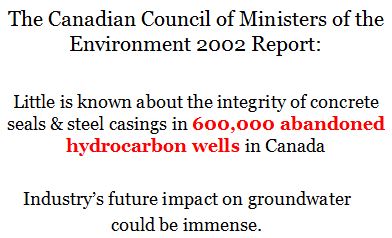Fracking Wells Abandoned in Boom/Bust Cycle. Who Will Pay to Cap Them? Climate Denial Crock of the Week with Peter Sinclair, January 4, 2014
Wyoming May Act to Plug Abandoned Wells as Natural Gas Boom Ends by Dan Frosch, December 24, 2013, The New York Times
Hundreds of abandoned drilling wells dot eastern Wyoming like sagebrush, vestiges of a natural gas boom that has been drying up in recent years as prices have plummeted. The companies that once operated the wells have all but vanished into the prairie, many seeking bankruptcy protection and unable to pay the cost of reclaiming the land they leased. Recent estimates have put the number of abandoned drilling operations in Wyoming at more than 1,200, and state officials said several thousand more might soon be orphaned by their operators.
Wyoming officials are now trying to address the problem amid concerns from landowners that the wells could contaminate groundwater and are a blight on the land. This month, Gov. Matt Mead proposed allocating $3 million to pay for plugging the wells and reclaiming the land around them. And the issue is expected to be debated during next year’s legislative session as lawmakers seek to hold drilling companies more accountable. …
The state’s Oil and Gas Conservation Commission already budgets $1 million a year to plug abandoned wells. And under the governor’s proposal, the commission would appropriate another $3 million over the next four years in an effort to restore property value and reduce the risk of contamination. The money would come from a conservation tax that oil and gas companies pay. Still, given the number of wells already abandoned and the concern that more will soon be deserted, the money is not expected to go far. The state estimated that closing the 1,200 wells already abandoned would cost about $8 million. Compounding the problem, state officials estimate that Wyoming may also have to plug 2,300 wells that are sitting idle but have not been entirely abandoned by operators. There are also 400 idle wells scattered across land owned by the Bureau of Land Management, which has its own criteria for determining when a well on its land is considered abandoned or idle. State officials said they would need to work with the bureau to help deal with those wells, too.
Governor Mead also wants the commission, which he sits on, to review the conservation tax and bonding requirements for drilling companies to determine whether they are sufficient. Currently, companies must pay a $75,000 blanket bond to cover all of the wells they operate — often numbering in the hundreds — on state and private land in Wyoming. Once a well stops producing and is deemed idle, the operator must pay up to $10 a linear foot in bonding to offset the cost of reclamation. But it is at that point that some companies drift into financial trouble and cannot pay the additional fees, leaving the state to scramble to make up the cost.
The governor’s proposal has drawn support from landowner groups like the Powder River Basin Coalition, which has been pushing the state to take a tougher tack toward financially marginal drilling companies. “There has been a lot of hand-holding and coddling over the years when it comes to oil and gas operators and their ability to pay the bonding,” said Jill Morrison, an organizer with the group. Ms. Morrison said that the issue had largely been ignored during Wyoming’s peak boom years — from 1995 to 2004. “We are really pleased there is an actual plan to move forward with an aggressive plugging and reclamation strategy,” she said. The proposal is also backed by the Petroleum Association of Wyoming, which favors raising the conservation tax to help pay for plugging fees. The group also supports higher bond fees for operators with tenuous finances. “It’s how you weed out companies that are too risky to go into business with,” said the group’s president, Bruce Hinchey.
But getting drilling companies who claim to be on the verge of collapse to take responsibility for wells they still technically own has proved difficult. One such company, Patriot Energy Resources, which owns about 900 idle wells on state and private land, said in an October letter to Governor Mead that it was $1.9 million short of full bonding on those wells after the bankruptcy filing of Luca Technologies, its parent company. Patriot has proposed allowing another drilling company to take on a part of its debt, saying it will have to abandon its wells otherwise. “Without this deal or something similar, Patriot will be forced to file for bankruptcy and turn these wells and reservoirs over to the state of Wyoming,” a company official wrote in the letter. … “All of this just came to a head at once,” said Mr. Hines, who heads the Senate’s minerals committee.
Last spring, Mr. Hines was told by Patriot that the hum of gas drilling activity on his own sprawling cattle ranch would soon grow quiet. Soon after, the company, which leased parcels of Mr. Hines’s land, disappeared completely — leaving behind more than 40 coal-bed methane wells and a jumble of pipes and pumps. “They informed me that they were shutting down because they were short of funds,” Mr. Hines said. “All of it, in my opinion, needs to be cleaned up.”
A version of this article appears in print on December 25, 2013, on page A16 of the New York edition with the headline: State May Act to Plug Abandoned Wyoming Wells as Natural Gas Boom Ends. [Emphasis added]
[Refer also to:
Slide from Ernst Presentation at Eagle Hill, Alberta in March 2012.

